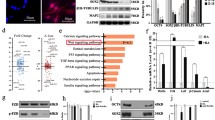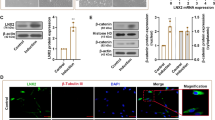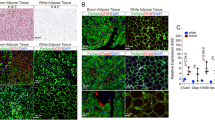Abstract
Since the nervous system has limited self-repair capability, a great interest in using stem cells is generated to repair it. The adipose tissue is an abundant source of stem cells and previous reports have shown the differentiation of them in neuron-like cells when cultures are enriched with growth factors involved in neurogenesis. Regarding this, it could be thought that a functional parallelism between neurogenesis and neuronal differentiation of human adipose stem cells (hASCs) exists. For this reason, we investigated the putative involvement of Notch and Wnt pathways in neuronal differentiation of hASCs through real-time PCR. We found that both Wnt and Notch signaling are present in proliferating hASCs and that both cascades are downregulated when cells are differentiated to a neuronal phenotype. These results are in concordance with previous works where it was found that both pathways are involved in the maintenance of the proliferative state of stem cells, probably through inhibition of the expression of cell-fate-specific genes. These results could support the notion that hASCs differentiation into neuron-like cells represents a regulated process analogous to what occurs during neuronal differentiation of NSCs and could partially contribute to elucidate the molecular mechanisms involved in neuronal differentiation of adult human nonneural tissues.


Similar content being viewed by others
References
Akai J, Halley PA, Storey KG (2005) FGF-dependent Notch signaling maintains the spinal cord stem zone. Genes Dev 19:2877–2887
Alexson TO, Hitoshi S, Coles BL, Bernstein A, van der Kooy D (2006) Notch signaling is required to maintain all neural stem cell populations—irrespective of spatial or temporal niche. Dev Neurosci 28:34–48
Androutsellis-Theotokis A, Leker RR, Soldner F et al (2006) Notch signalling regulates stem cell numbers in vitro and in vivo. Nature 442:823–826
Anghileri E, Marconi S, Pignatelli A et al (2008) Neuronal differentiation potential of human adipose-derived mesenchymal stem cells. Stem Cells Dev 17:909–916
Artavanis-Tsakonas S, Rand MD, Lake RJ (1999) Notch signaling: cell fate control and signal integration in development. Science 284:770–776
Ashjian PH, Elbarbary AS, Edmonds B et al (2003) In vitro differentiation of human processed lipoaspirate cells into early neural progenitors. Plast Reconstr Surg 111:1922–1931
Baek SH, Kioussi C, Briata P et al (2003) Regulated subset of G1 growth-control genes in response to derepression by the Wnt pathway. Proc Natl Acad Sci USA 100:3245–3250
Bain G, Kitchens D, Yao M, Huettner JE, Gottlieb DI (1995) Embryonic stem cells express neuronal properties in vitro. Dev Biol 168:342–357
Baker JC, Beddington RS, Harland RM (1999) Wnt signaling in Xenopus embryos inhibits bmp4 expression and activates neural development. Genes Dev 13:3149–3159
Bennett CN, Ross SE, Longo KA et al (2002) Regulation of Wnt signaling during adipogenesis. J Biol Chem 277:30998–31004
Boquest AC, Shahdadfar A, Fronsdal K (2005) Isolation and transcription profiling of purified uncultured human stromal stem cells: alteration of gene expression after in vitro cell culture. Mol Biol Cell 16:1131–1141
Bray SJ (2006) Notch signalling: a simple pathway becomes complex. Nat Rev Mol Cell Biol 7:678–689
Cadigan KM, Nusse R (1997) Wnt signaling: a common theme in animal development. Genes Dev 11:3286–3305
Cai C, Thorne J, Grabel L (2008) Hedgehog serves as a mitogen and survival factor during embryonic stem cell neurogenesis. Stem Cells 26:1097–1108
Cardozo A, Ielpi M, Gomez D, Argibay P (2010) Differential expression of Shh and BMP signaling in the potential conversion of human adipose tissue stem cells into neuron-like cells in vitro. Gene Expr 14:307–319
Castelo-Branco G, Wagner J, Rodriguez FJ et al (2003) Differential regulation of midbrain dopaminergic neuron development by Wnt-1, Wnt-3a, and Wnt-5a. Proc Natl Acad Sci USA 100:12747–12752
Chi GF, Kim MR, Kim DW, Jiang MH, Son Y (2010) Schwann cells differentiated from spheroid-forming cells of rat subcutaneous fat tissue myelinate axons in the spinal cord injury. Exp Neurol 222:304–317
Chiba S (2006) Notch signaling in stem cell systems. Stem Cells 24:2437–2447
Cho HH, Kim YJ, Kim SJ et al (2006) Endogenous Wnt signaling promotes proliferation and suppresses osteogenic differentiation in human adipose derived stromal cells. Tissue Eng 12:111–121
Dale TC (1998) Signal transduction by the Wnt family of ligands. Biochem J 329(Pt 2):209–223
Dejmek J, Safholm A, Kamp NC, Andersson T, Leandersson K (2006) Wnt-5a/Ca2±-induced NFAT activity is counteracted by Wnt-5a/Yes-Cdc42-casein kinase 1alpha signaling in human mammary epithelial cells. Mol Cell Biol 26:6024–6036
Dhar S, Yoon ES, Kachgal S, Evans GR (2007) Long-term maintenance of neuronally differentiated human adipose tissue-derived stem cells. Tissue Eng 13:2625–2632
Dorsky RI, Moon RT, Raible DW (1998) Control of neural crest cell fate by the Wnt signalling pathway. Nature 396:370–373
Duncan AW, Rattis FM, DiMascio LN et al (2005) Integration of Notch and Wnt signaling in hematopoietic stem cell maintenance. Nat Immunol 6:314–322
Etheridge SL, Spencer GJ, Heath DJ, Genever PG (2004) Expression profiling and functional analysis of wnt signaling mechanisms in mesenchymal stem cells. Stem Cells 22:849–860
Fischer A, Gessler M (2007) Delta-Notch–and then? Protein interactions and proposed modes of repression by Hes and Hey bHLH factors. Nucleic Acids Res 35:4583–4596
Freed CR, Greene PE, Breeze RE et al (2001) Transplantation of embryonic dopamine neurons for severe Parkinson’s disease. N Engl J Med 344:710–719
Gage FH (2000) Mammalian neural stem cells. Science 287:1433–1438
Gaiano N, Fishell G (2002) The role of notch in promoting glial and neural stem cell fates. Annu Rev Neurosci 25:471–490
Gronthos S, Franklin DM, Leddy HA, Robey PG, Storms RW, Gimble JM (2001) Surface protein characterization of human adipose tissue-derived stromal cells. J Cell Physiol 189:54–63
Hall AC, Lucas FR, Salinas PC (2000) Axonal remodeling and synaptic differentiation in the cerebellum is regulated by WNT-7a signaling. Cell 100:525–535
Hartmann C, Tabin CJ (2000) Dual roles of Wnt signaling during chondrogenesis in the chicken limb. Development 127:3141–3159
Hauner H, Schmid P, Pfeiffer EF (1987) Glucocorticoids and insulin promote the differentiation of human adipocyte precursor cells into fat cells. J Clin Endocrinol Metab 64:832–835
He TC, Sparks AB, Rago C et al (1998) Identification of c-MYC as a target of the APC pathway. Science 281:1509–1512
Huelsken J, Behrens J (2002) The Wnt signalling pathway. J Cell Sci 115:3977–3978
Hurlbut GD, Kankel MW, Lake RJ, Artavanis-Tsakonas S (2007) Crossing paths with Notch in the hyper-network. Curr Opin Cell Biol 19:166–175
Ishitani T, Ninomiya-Tsuji J, Nagai S et al (1999) The TAK1-NLK-MAPK-related pathway antagonizes signalling between beta-catenin and transcription factor TCF. Nature 399:798–802
Iso T, Kedes L, Hamamori Y (2003) HES and HERP families: multiple effectors of the Notch signaling pathway. J Cell Physiol 194:237–255
Israsena N, Hu M, Fu W, Kan L, Kessler JA (2004) The presence of FGF2 signaling determines whether beta-catenin exerts effects on proliferation or neuronal differentiation of neural stem cells. Dev Biol 268:220–231
Jang S, Cho HH, Cho YB, Park JS, Jeong HS (2010) Functional neural differentiation of human adipose tissue-derived stem cells using bFGF and forskolin. BMC Cell Biol 11:25
Jiang J, Struhl G (1998) Regulation of the Hedgehog and Wingless signalling pathways by the F-box/WD40-repeat protein Slimb. Nature 391:493–496
Kageyama R, Ohtsuka T, Hatakeyama J, Ohsawa R (2005) Roles of bHLH genes in neural stem cell differentiation. Exp Cell Res 306:343–348
Kang SK, Lee DH, Bae YC, Kim HK, Baik SY, Jung JS (2003) Improvement of neurological deficits by intracerebral transplantation of human adipose tissue-derived stromal cells after cerebral ischemia in rats. Exp Neurol 183:355–366
Karanu FN, Yuefei L, Gallacher L, Sakano S, Bhatia M (2003) Differential response of primitive human CD34- and CD34 ± hematopoietic cells to the Notch ligand Jagged-1. Leukemia 17:1366–1374
Kasai M, Satoh K, Akiyama T (2005) Wnt signaling regulates the sequential onset of neurogenesis and gliogenesis via induction of BMPs. Genes Cells 10:777–783
Katoh M, Katoh M (2006) Notch ligand, JAG1, is evolutionarily conserved target of canonical WNT signaling pathway in progenitor cells. Int J Mol Med 17:681–685
Katz AJ, Tholpady A, Tholpady SS, Shang H, Ogle RC (2005) Cell surface and transcriptional characterization of human adipose-derived adherent stromal (hADAS) cells. Stem Cells 23:412–423
Kim JM, Lee ST, Chu K et al (2007) Systemic transplantation of human adipose stem cells attenuated cerebral inflammation and degeneration in a hemorrhagic stroke model. Brain Res 1183:43–50
Kulikov AV, Stepanova MS, Stvolinsky SL et al (2008) Application of multipotent mesenchymal stromal cells from human adipose tissue for compensation of neurological deficiency induced by 3-nitropropionic Acid in rats. Bull Exp Biol Med 145:514–519
Lai EC (2004) Notch signaling: control of cell communication and cell fate. Development 131:965–973
Lee HY, Kleber M, Hari L et al (2004) Instructive role of Wnt/beta-catenin in sensory fate specification in neural crest stem cells. Science 303:1020–1023
Levy YS, Merims D, Panet H, Barhum Y, Melamed E, Offen D (2003) Induction of neuron-specific enolase promoter and neuronal markers in differentiated mouse bone marrow stromal cells. J Mol Neurosci 21:121–132
Lewis J (1996) Neurogenic genes and vertebrate neurogenesis. Curr Opin Neurobiol 6:3–10
Ling L, Nurcombe V, Cool SM (2009) Wnt signaling controls the fate of mesenchymal stem cells. Gene 433:1–7
Lyden D, Young AZ, Zagzag D et al (1999) Id1 and Id3 are required for neurogenesis, angiogenesis and vascularization of tumour xenografts. Nature 401:670–677
Mareschi K, Novara M, Rustichelli D et al (2006) Neural differentiation of human mesenchymal stem cells: Evidence for expression of neural markers and eag K ± channel types. Exp Hematol 34:1563–1572
Maric D, Maric I, Chang YH, Barker JL (2003) Prospective cell sorting of embryonic rat neural stem cells and neuronal and glial progenitors reveals selective effects of basic fibroblast growth factor and epidermal growth factor on self-renewal and differentiation. J Neurosci 23:240–251
McCaffery PJ, Adams J, Maden M, Rosa-Molinar E (2003) Too much of a good thing: retinoic acid as an endogenous regulator of neural differentiation and exogenous teratogen. Eur J Neurosci 18:457–472
McKay R (1997) Stem cells in the central nervous system. Science 276:66–71
Morin PJ, Sparks AB, Korinek V et al (1997) Activation of beta-catenin-Tcf signaling in colon cancer by mutations in beta-catenin or APC. Science 275:1787–1790
Papkoff J (1994) Identification and biochemical characterization of secreted Wnt-1 protein from P19 embryonal carcinoma cells induced to differentiate along the neuroectodermal lineage. Oncogene 9:313–317
Patapoutian A, Reichardt LF (2000) Roles of Wnt proteins in neural development and maintenance. Curr Opin Neurobiol 10:392–399
Peroni D, Scambi I, Pasini A et al (2008) Stem molecular signature of adipose-derived stromal cells. Exp Cell Res 314:603–615
Reya T, Duncan AW, Ailles L et al (2003) A role for Wnt signalling in self-renewal of haematopoietic stem cells. Nature 423:409–414
Reynolds BA, Weiss S (1992) Generation of neurons and astrocytes from isolated cells of the adult mammalian central nervous system. Science 255:1707–1710
Richards LJ, Kilpatrick TJ, Bartlett PF (1992) De novo generation of neuronal cells from the adult mouse brain. Proc Natl Acad Sci USA 89:8591–8595
Ross SE, Hemati N, Longo KA et al (2000) Inhibition of adipogenesis by Wnt signaling. Science 289:950–953
Safford KM, Hicok KC, Safford SD et al (2002) Neurogenic differentiation of murine and human adipose-derived stromal cells. Biochem Biophys Res Commun 294:371–379
Salinas PC (2003) Synaptogenesis: Wnt and TGF-beta take centre stage. Curr Biol 13:R60–R62
Tang K, Yang J, Gao X et al (2002) Wnt-1 promotes neuronal differentiation and inhibits gliogenesis in P19 cells. Biochem Biophys Res Commun 293:167–173
Tao H, Rao R, Ma DD (2005) Cytokine-induced stable neuronal differentiation of human bone marrow mesenchymal stem cells in a serum/feeder cell-free condition. Dev Growth Differ 47:423–433
Viti J, Gulacsi A, Lillien L (2003) Wnt regulation of progenitor maturation in the cortex depends on Shh or fibroblast growth factor 2. J Neurosci 23:5919–5927
Walsh J, Andrews PW (2003) Expression of Wnt and Notch pathway genes in a pluripotent human embryonal carcinoma cell line and embryonic stem cell. APMIS 111:197–210, discussion 210–1
Wei X, Zhao L, Zhong J et al (2009) Adipose stromal cells-secreted neuroprotective media against neuronal apoptosis. Neurosci Lett 462:76–79
Willert K, Brown JD, Danenberg E et al (2003) Wnt proteins are lipid-modified and can act as stem cell growth factors. Nature 423:448–452
Woodbury D, Schwarz EJ, Prockop DJ, Black IB (2000) Adult rat and human bone marrow stromal cells differentiate into neurons. J Neurosci Res 61:364–370
Yu X, Alder JK, Chun JH et al (2006) HES1 inhibits cycling of hematopoietic progenitor cells via DNA binding. Stem Cells 24:876–888
Zechner D, Fujita Y, Hulsken J et al (2003) beta-Catenin signals regulate cell growth and the balance between progenitor cell expansion and differentiation in the nervous system. Dev Biol 258:406–418
Zuk PA, Zhu M, Ashjian P et al (2002) Human adipose tissue is a source of multipotent stem cells. Mol Biol Cell 13:4279–4295
Zuk PA, Zhu M, Mizuno H et al (2001) Multilineage cells from human adipose tissue: implications for cell-based therapies. Tissue Eng 7:211–228
Acknowledgments
This study was funded by the Fundación para el desarrollo de las Ciencias Básicas (FUCIBA) and the Instituto de Ciencias Básicas y Medicina Experimental (ICBME), Hospital Italiano de Buenos Aires, Argentina. Financial support by Consejo Nacional de Investigaciones Científicas y Técnicas (CONICET) through a scholarship to Alejandra Johana Cardozo is gratefully acknowledged. D.E. Gomez is a member of CONICET.
Author information
Authors and Affiliations
Corresponding author
Rights and permissions
About this article
Cite this article
Cardozo, A.J., Gómez, D.E. & Argibay, P.F. Transcriptional Characterization of Wnt and Notch Signaling Pathways in Neuronal Differentiation of Human Adipose Tissue-Derived Stem Cells. J Mol Neurosci 44, 186–194 (2011). https://doi.org/10.1007/s12031-011-9503-9
Received:
Accepted:
Published:
Issue Date:
DOI: https://doi.org/10.1007/s12031-011-9503-9




